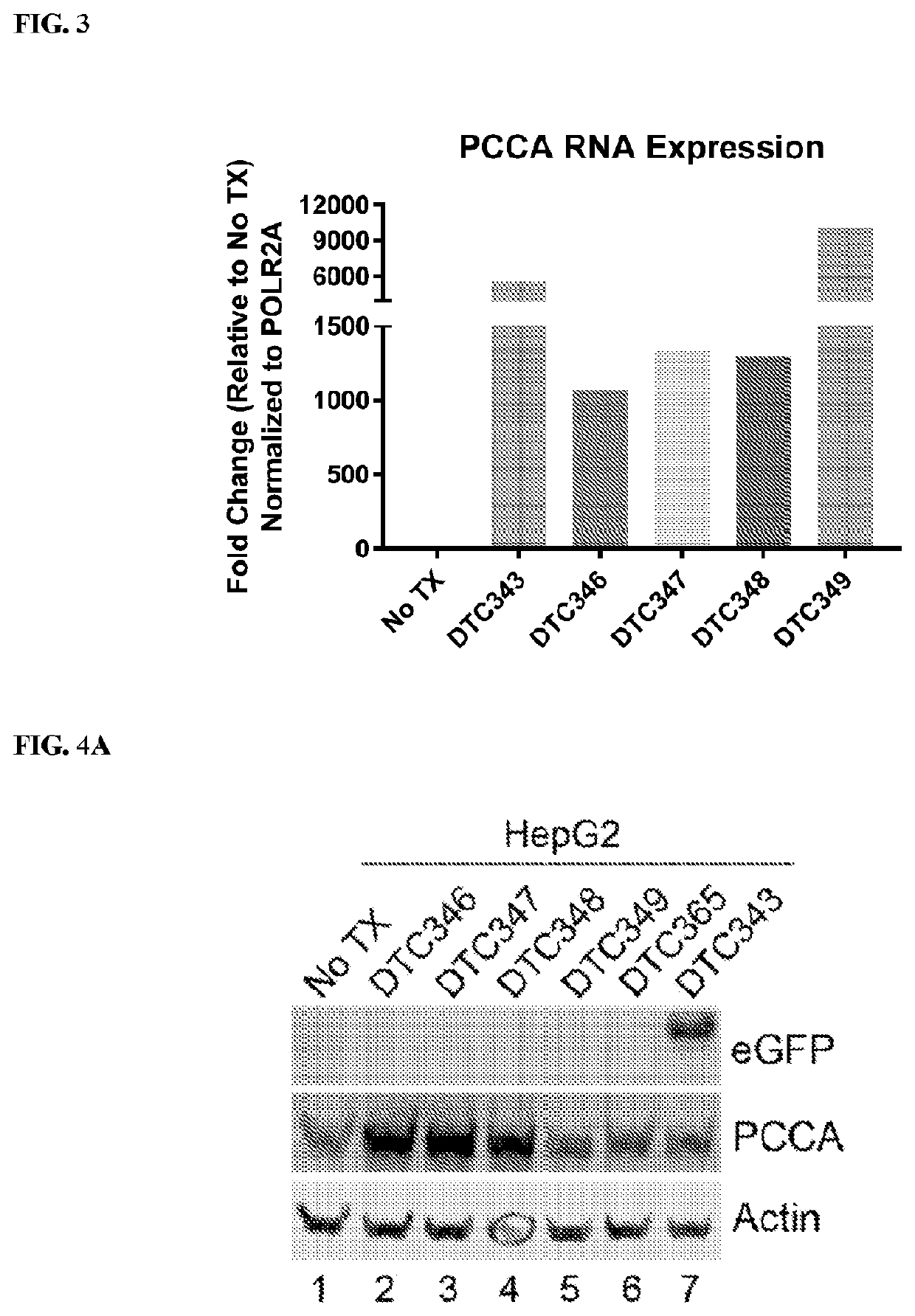Gene therapy for treating propionic acidemia
a technology of propionic acidemia and gene therapy, which is applied in the field of gene therapy for treating propionic acidemia, can solve the problems of poor long-term prognosis of patients with pa
- Summary
- Abstract
- Description
- Claims
- Application Information
AI Technical Summary
Benefits of technology
Problems solved by technology
Method used
Image
Examples
example 1
rotein Expression of PCCA
RNA Expression
[0189]This example relates to RNA expression of PCCA following transfection of continuous hepatocyte cell line (HepG2) as determined by RT-qPCR. Briefly, HepG2 cells were transfected with a control plasmid (plasmid with an empty vector, No TX), an rAAV vector plasmid carrying a nucleotide sequence encoding enhanced green fluorescent protein, eGFP (DTC343), an rAAV vector plasmid carrying a nucleotide sequence encoding the complete native sequence of human PCCA (DTC346), or an rAAV vector plasmid carrying a nucleotide sequence encoding a codon-optimized sequence of human PCCA (DTC347, DTC348, or DTC349) using Lipofectamine 2000 (Invitrogen) according to manufacturer's instructions. HepG2 cells were harvested 72 hours post-transfection and lysed. RNA was extracted from the lysed HepG2 cells using TRIzol reagent (Invitrogen) according to the manufacturer's instructions. The quality and quantity of RNA were measured using NanoDrop ND-1000 (Thermo S...
example 2
ssed Human PCCA Protein Localizes to Mitochondria
[0196]This example shows that human PCCA overexpressed in continuous hepatocyte cell line (HepG2) localizes to mitochondria. Briefly, continuous hepatocyte cell line (HepG2) was transfected with an rAAV vector plasmid carrying a nucleotide sequence encoding the complete native sequence of human PCCA (DTC346). Following transfection, cells were subjected to subcellular fractionation where cytoplasmic and mitochondrial fractions were isolated. Whole cell lysates were also processed. Proteins were resolved on 10% sodium dodecyl sulfate polyacrylamide electrophoresis (SDS-PAGE) gels and transferred onto IMMUN-BLOT© polyvinylidene fluoride (PVDF) membrane (Bio-Rad). Western blot analysis was performed using anti-PCCA (Abcam, Cambridge, UK) antibody at 1:1000 dilution followed by a secondary antibody conjugated to far red fluorophores (Licor IRDye Secondary Antibodies). FIG. 5 is an image showing PCCA protein expression levels, detected by ...
example 3
n of PCCA AAV9 Titer Yield
[0198]This example relates to comparison of PCCA AAV9 titer yield from rAAV vector plasmid carrying a nucleotide sequence encoding the complete native sequence of human PCCA (DTC346) or an rAAV vector plasmid carrying a nucleotide sequence encoding a codon-optimized sequence of human PCCA (DTC347, DTC348, or DTC349). A continuous kidney cell line (HEK293) was triple transfected with an rAAV vector plasmid carrying a nucleotide sequence encoding the complete native sequence of human PCCA (DTC346), an rAAV vector plasmid carrying a nucleotide sequence encoding a codon-optimized sequence of human PCCA (DTC347, DTC348, or DTC349), or an rAAV vector plasmid carrying a nucleotide sequence encoding enhanced green fluorescent protein, eGFP (DTC343); each were expressed in a cell co-transfected with an AAV9 capsid expressing plasmid (pAAV2 / 9) and a plasmid supplying adenovirus helper functions (pAdHelper). Untransfected cells were used as control and are represented...
PUM
| Property | Measurement | Unit |
|---|---|---|
| pH | aaaaa | aaaaa |
| pH | aaaaa | aaaaa |
| pH | aaaaa | aaaaa |
Abstract
Description
Claims
Application Information
 Login to View More
Login to View More - R&D
- Intellectual Property
- Life Sciences
- Materials
- Tech Scout
- Unparalleled Data Quality
- Higher Quality Content
- 60% Fewer Hallucinations
Browse by: Latest US Patents, China's latest patents, Technical Efficacy Thesaurus, Application Domain, Technology Topic, Popular Technical Reports.
© 2025 PatSnap. All rights reserved.Legal|Privacy policy|Modern Slavery Act Transparency Statement|Sitemap|About US| Contact US: help@patsnap.com



